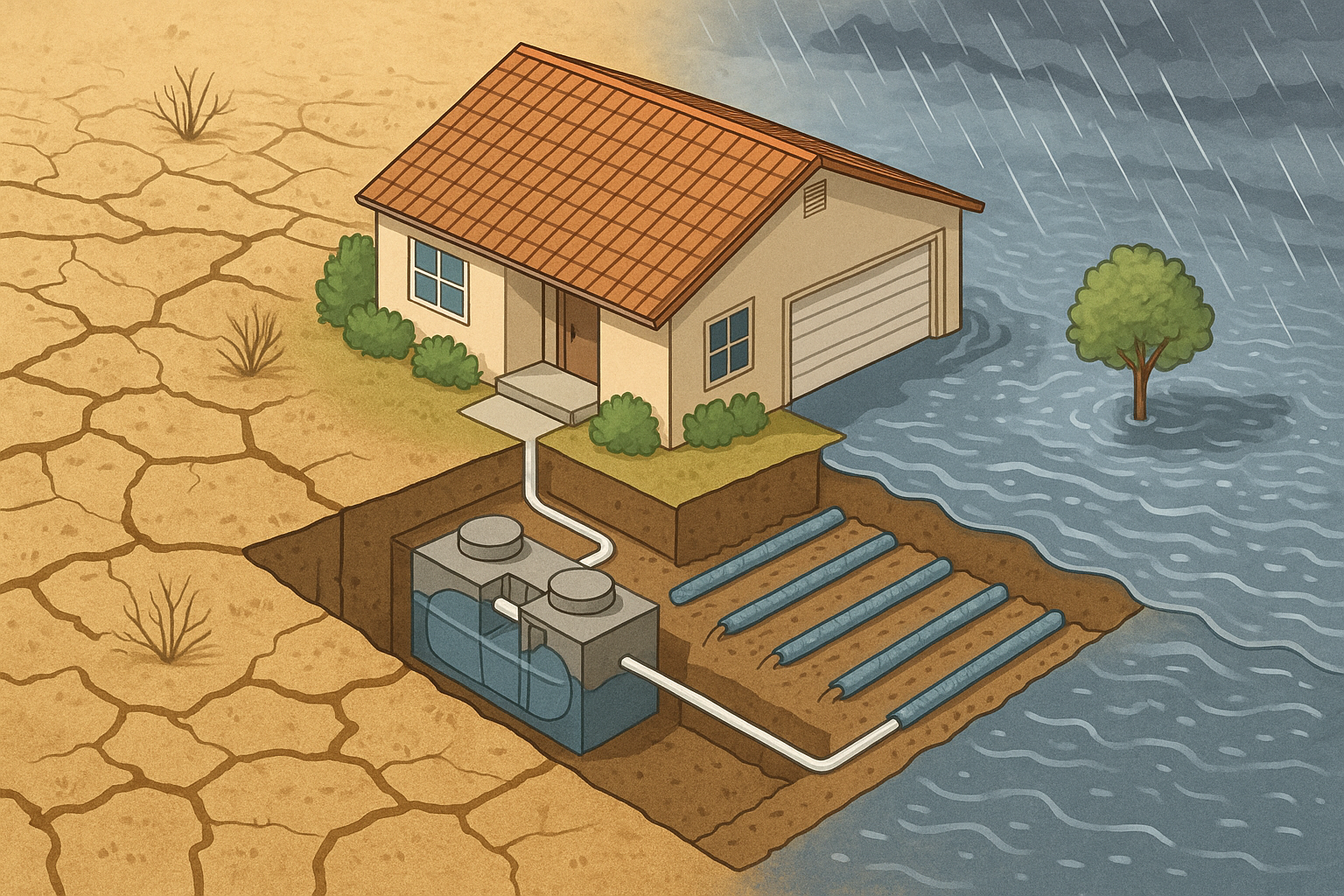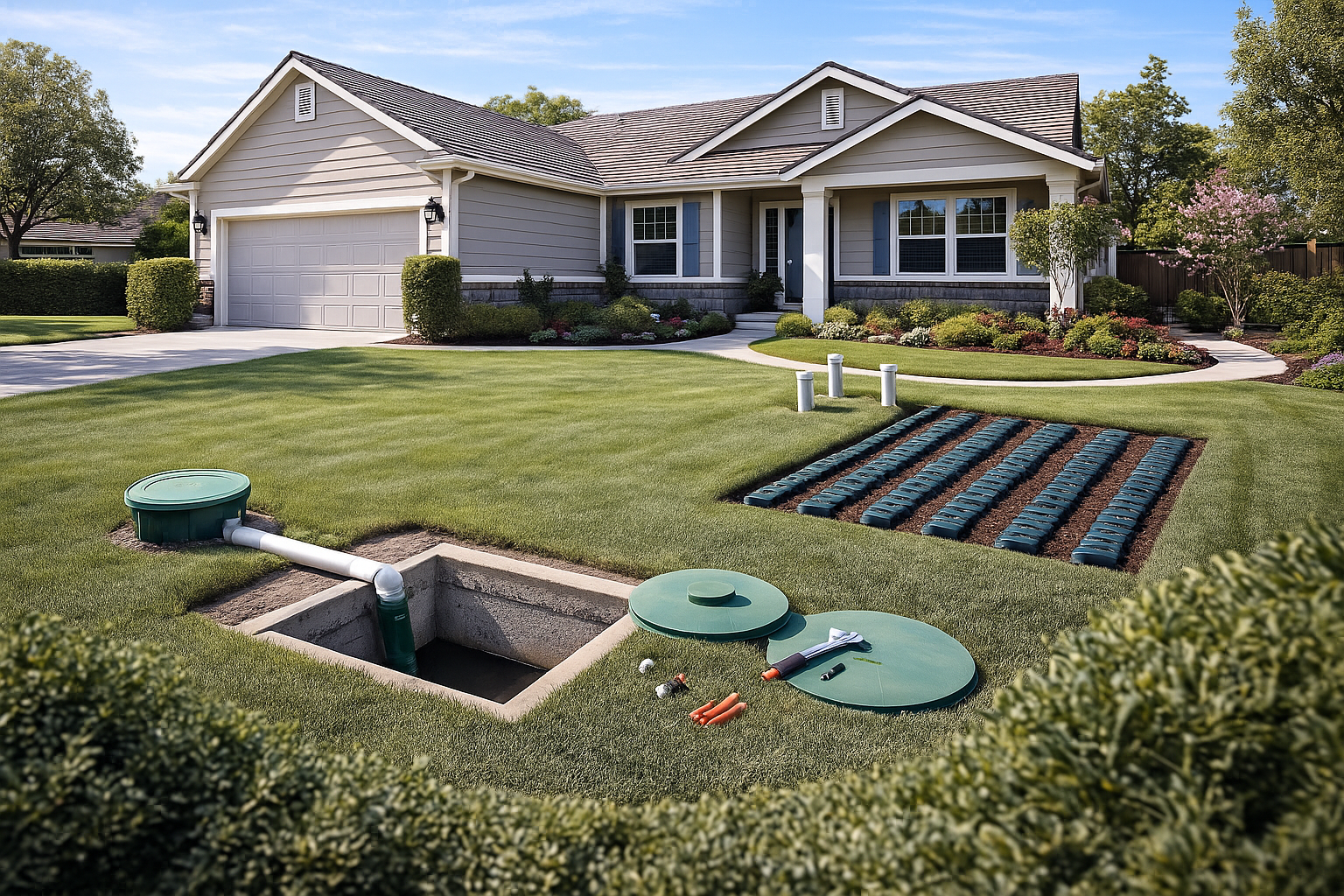Have you ever thought about how climate change septic systems California, rising temperatures septic maintenance, or drought effects on septic tanks might be affecting your home’s septic system? Most people notice the visible impacts of climate change, such as wildfires, water restrictions, or heat waves, but few realize the hidden strain on the systems underground that manage household wastewater.
When a septic system fails due to climate-related stress, septic system failure climate can lead to costly repairs, unpleasant odors, and contamination risks. In California, with increasingly extreme weather patterns, septic systems face unique and growing challenges. Intense rainstorms can cause heavy rainfall septic overflow, flooding drain fields and overwhelming tanks.
Learn more about how to protect your septic system from heavy rain and flooding. Prolonged droughts compromise soil filtration and water absorption. Hotter temperatures accelerate bacterial activity inside the tank, requiring more diligent rising temperatures septic maintenance to maintain proper breakdown. Coastal homeowners must also consider sea level rise septic problems, which elevate groundwater tables and threaten system integrity.
Integrating water conservation septic care strategies, including eco friendly septic practices, allows homeowners to mitigate risks before they become emergencies. Maintaining a regular septic tank maintenance schedule and arranging septic inspection California ensures early identification of potential issues, reducing the chance of expensive septic repair cost California. By taking informed, preventative measures, California homeowners protect their property while supporting broader California wastewater management climate initiatives.
A Changing Climate and California’s Septic Systems
Septic systems have quietly supported households across California, particularly in rural and semi-rural areas, where municipal sewer lines are unavailable. Historically, these systems worked reliably by using natural processes: wastewater flows into the tank, solids settle, and liquid effluent filters through soil for treatment before returning to the groundwater.
However, increasing climate pressures now challenge these systems with soil saturation septic issues, groundwater contamination California, and sea level rise septic problems. The effectiveness of a septic system depends on healthy soil, stable groundwater levels, and predictable weather patterns. Drain fields, or leach fields, allow wastewater to disperse and be naturally treated.
Flooding, drought, or rising water tables can disrupt this process, increasing risks of stormwater runoff septic systems contamination. Intense rainfall events can lead to heavy rainfall septic overflow, while extended droughts exacerbate drought effects on septic tanks, reducing soil absorption capacity.
Coastal regions face additional pressure from rising seas, which elevate groundwater and threaten older systems. Planning for drought resistant septic design and integrating climate adaptation wastewater measures, along with regular septic inspection California, helps maintain system integrity.
Staying up to date with environmental regulations septic systems and learning the differences between grease traps vs. septic tanks ensures compliance and reduces future risks. By understanding the interconnectedness of climate, soil, and system design, homeowners can protect both their property and local water quality, contributing to sustainable California wastewater management climate practices.
How Climate Change Disrupts the Septic System Balance
A septic system is designed to work in a delicate balance, relying on consistent soil, groundwater levels, and predictable weather patterns. Increasing climate extremes in California are making this balance harder to maintain. Droughts, floods, and heat waves all stress systems in unique ways.
For instance, soil saturation septic issues occur when heavy rainfall overwhelms drainage areas, reducing soil’s ability to filter wastewater safely. Conversely, prolonged droughts and compacted soils from drought effects on septic tanks make natural filtration less effective, increasing the risk of groundwater contamination California.
Elevated temperatures accelerate bacterial activity inside tanks, highlighting the need for diligent rising temperatures septic maintenance and septic efficiency improvement practices. Drain fields, or leach fields, are particularly vulnerable; disruptions from flooding, erosion, or compaction caused by stormwater runoff septic systems reduce the system’s ability to handle waste effectively.
Older systems are especially at risk due to aging septic infrastructure and may require septic replacement California to maintain safety and efficiency. Regular inspections, such as septic tank inspection near me, and septic pumping California ensure early detection of stress points. Coastal homeowners must also monitor sea level rise septic problems to prevent backups.
By understanding these factors and integrating eco friendly septic practices, homeowners can strengthen septic climate resilience California, preventing damage, reducing costs, and maintaining healthy wastewater management systems despite increasing climate pressures.
Why Building a Climate-Resilient Septic System Matters
Adapting your septic system to climate realities offers multiple benefits for both your home and the environment. Proactive maintenance helps reduce septic repair cost California by addressing vulnerabilities early, preventing emergency replacements and costly fixes. Following a consistent septic tank maintenance schedule and septic pumping California routine prolongs system life and maximizes efficiency.
Well-maintained systems also support household wastewater sustainability by preventing untreated wastewater from seeping into local soil and aquifers. Integrating eco friendly septic practices, such as proper landscaping, rainwater diversion, and soil-friendly filtration, protects natural ecosystems and reduces environmental impact septic waste.
Extreme weather events, such as storms, droughts, and wildfires, can lead to extreme weather septic damage or wildfire aftermath septic damage, highlighting the importance of septic resilience solutions. Homeowners benefit from peace of mind knowing that their systems can withstand challenges from heavy rainfall septic overflow, droughts, or heatwaves. Coastal residents must consider sea level rise septic problems, while rural homeowners should review rural California septic impact and rural water management
California. Upgrading older systems with modern innovative septic technology or seeking professional septic contractors California ensures compliance with California septic code updates and evolving environmental regulations septic systems. Ultimately, investing in a climate-smart septic system safeguards your home, protects public health, and supports sustainable California wastewater management climate.
Challenges of Maintaining Septic Systems in a Changing Climate
Maintaining a septic system amid shifting climate conditions is not without challenges. Upfront costs for upgrades or septic installation California can be high, particularly for older systems requiring septic replacement California or new drain field designs. Homeowners must navigate complex environmental regulations septic systems, including septic permitting California, to remain compliant with evolving rules.
More frequent inspections and septic tank inspection near me add time and planning demands. Extreme weather events, such as floods or wildfires, can cause extreme weather septic damage or wildfire aftermath septic damage, stressing even well-maintained systems. In rural areas, access to qualified septic contractors California may be limited, delaying repairs or preventive care.
Despite these hurdles, small, manageable strategies can prevent significant damage. Start with routine inspections, proper septic tank maintenance schedule, septic pumping California, and eco friendly septic practices. Landscaping adjustments, like drought resistant septic design, improve drainage and soil health, mitigating soil saturation septic issues.
Prioritizing water conservation septic care, planning for gradual upgrades, and leveraging local resources ensures homeowners remain prepared. By approaching maintenance proactively and patiently, the long-term resilience of climate change septic systems California can be safeguarded, reducing costs, environmental risks, and the likelihood of system failure.
Practical Steps to Protect Your Septic System
Protecting your septic system against climate impacts requires consistent, practical steps:
- Schedule Regular Inspections – Work with certified professionals for septic inspection California to detect early issues. Learn more about septic pump outs and the pump truck process.
- Pump on Schedule – Follow the recommended septic tank maintenance schedule and septic pumping California for optimal performance. See the risks and benefits of DIY septic tank pump-outs.
- Manage Water Use Wisely – Spread out usage, fix leaks quickly, and implement water conservation septic care practices.
- Protect the Drain Field – Avoid compaction and prevent stormwater runoff septic systems damage. Guidance on protecting your septic system from flooding.
- Adapt Landscaping – Utilize drought resistant septic design, drought-tolerant plants, and soil-friendly grading.
- Plan for Upgrades – Older systems benefit from innovative septic technology, septic resilience solutions, or new septic installation California options to improve septic climate resilience California.
Additional resources include County Environmental Health Departments, EPA SepticSmart Program, California Water Boards, and local septic contractors California. Regular, small steps like eco friendly septic practices, septic efficiency improvement, and monitoring for extreme weather septic damage protect both property and the environment. Septic tank pump-out regulations should also be followed. By combining preventive care with strategic upgrades, homeowners contribute to sustainable wastewater treatment and maintain safe groundwater protection septic systems.
The Future of Septic Systems in California
Septic systems are entering a new era of innovation, driven by climate change. Smarter systems with sensors, innovative septic technology, and adaptive designs improve septic climate resilience California. Stricter environmental regulations septic systems and California septic code updates are pushing communities toward safer practices. Coastal areas face sea level rise septic problems, while rural regions consider shared rural water management California systems.
Emerging eco friendly septic practices and sustainable wastewater treatment turn wastewater into a resource, improving household wastewater sustainability. Professionals such as septic contractors California will be increasingly in demand for upgrades, maintenance, and septic installation California. Homeowners can expect both greater peace of mind and more responsibility to monitor systems proactively, ensuring septic resilience solutions are implemented.
The future requires a balance of innovation, regulation, and community collaboration to maintain safe, efficient, and environmentally responsible California wastewater management climate.
Building Resilience Starts at Home
Key takeaways:
- Climate change disrupts septic performance—heavy rainfall septic overflow, drought effects on septic tanks, and rising temperatures septic maintenance all impact system balance.
- Proactive care, including septic tank inspection near me, septic pumping California, and eco friendly septic practices, extends system lifespan.
- Modern innovative septic technology, drought resistant septic design, and septic resilience solutions support long-term safety.
Every small action, from inspections to upgrades, strengthens your home and contributes to a cleaner, safer, and more resilient California. Maintaining a climate-resilient system ensures both property protection and environmental responsibility.






